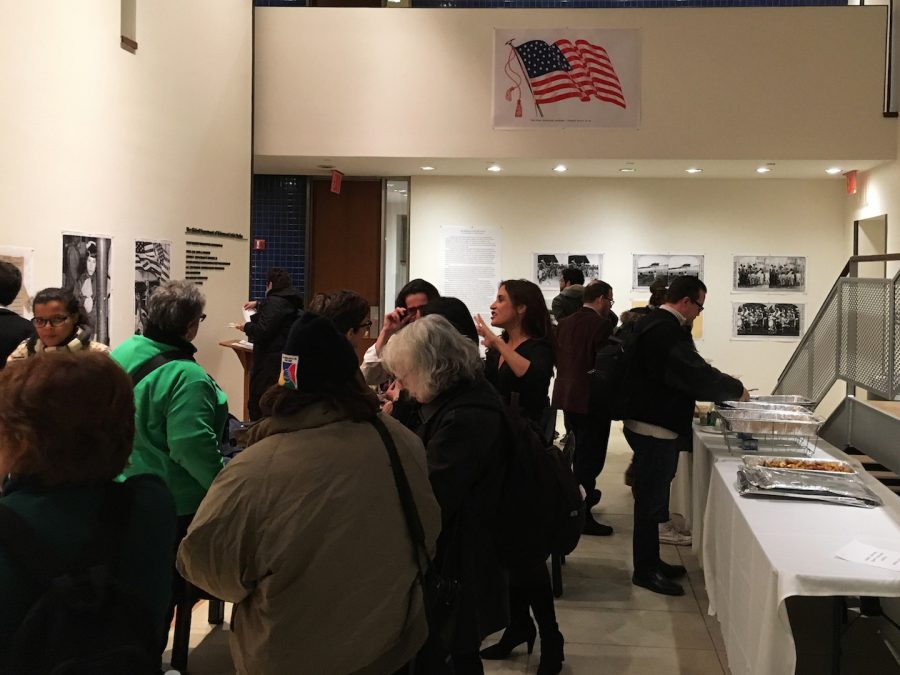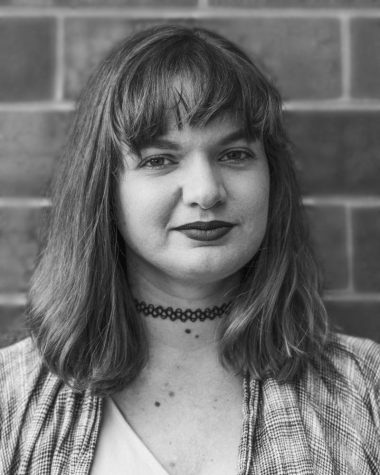Looming Large, Imperially Taking Charge
An eerie reminder of the United States’ dominating relationship with Puerto Rico looms over attendees of Thursday night’s panel at the “Museum of the Old Colony” exhibit. The exhibit will be on display at the King Juan Carlos I of Spain Center until March 16.
February 22, 2017
The air was filled with tension and contemplation at the Feb. 16 panel event at NYU’s King Juan Carlos I of Spain Center. The event was in coordination with the center’s current exhibit — curated by artist and Trinity College professor Pablo Delano — titled “Museum of the Old Colony.” Following the discussion, audience members milled around amongst images of Puerto Ricans around the 1950s that documented the life of the United States’ newest colony through the lens of stateside photographers. Captions drew grimaces and short laughs. Above the crowd hung an illustration of the U.S. flag with the caption “The Star Spangled Banner: Puerto Rico’s Flag.”
The evening was hosted by KJCC Director Ana Dopico and featured discussions with New York Times journalist, columnist and editor David Gonzalez; NYU cultural anthropology professor Arlene Davila; Puerto Rican artist and curator Nelson Rivera and photojournalist Erika P. Rodriguez. Each of the speakers — including the artist, Delano — has ties to Puerto Rico either by birth or by heritage and used their experiences, both on the island and in the contiguous United States, to inform their responses.
Rivera began the night by offering his own personal response to the exhibit. He observed that it was less a reflection of Puerto Rico than it was of the Americans who had sent in troops to forcibly take possession of the island. He pointed out the images that pictured the presence of U.S. troops as a normal aspect of Puerto Rican life — freedom from the Spanish with help from everyone’s favorite G.I. Joes.
“This is a work that shows Puerto Ricans who the colonizer really is,” Rivera said. “It looks at a time when America was [laughs] great.”
Davila spoke next, reminding the audience that photography influences public memory in a way that other forms of media struggle with. She focused on the exhibit’s inclusion of several stereoscope images — images that would have been used with a then-novel tool to make photographs look three-dimensional. The images conveys a sense of reality and truth to viewers, despite the obvious framing and choices that go into creating photographs and marketing them to consumers.
With tangible distress, Davila recalled the stereoscope “Waiting For Uncle Sam” that hung just outside the auditorium, showing carefree children standing nude on the coast of the island and the stereoscope’s original caption.
The caption on the photograph read “Childhood of whatever nationality or condition is an interesting and amusing study; and on the Porto Rican soil, where all tropical verdure thrives with great luxuriance under the sun’s warm rays, the color children multiply and flourish without much attention or care, and are seen swarming about in all their native simplicity and innocence.”
Davila’s discomfort was not singular — later, Gonzalez made parallels to the disgust he felt toward the word “sanitary” in the caption of the photograph “Tropical Milkshake.” The image pictures a young American tourist child drinking from a coconut through a “sanitary straw” while a Puerto Rican man prepares more coconuts with his “razor-sharp” machete.
Perhaps most thought-provoking in the abstract were the comments from Rivera, who drew attention to the way the exhibit’s photographs offered an outlet of voyeurism to U.S. citizens, both now and during the time they were first circulated, when Puerto Ricans were not counted among the U.S. citizen population. Rivera’s comments were almost disturbing as he detailed the other-izing of Puerto Ricans in the images and the rhetoric that accompanied them.
But the most powerful comments of the evening came from Rodriguez, who was born in Puerto Rico and lived in California for six and a half years before returning to the island to work as a photojournalist in a place sorely mis- and underrepresented in U.S. media. Her reaction to the exhibit was accompanied by a slideshow of her own photographs of Puerto Rico, showing a nation more complex and perhaps more troubling than the one seen in the exhibit’s images. She voiced her frustrations with the political and legislative failures and obstacles that Puerto Rico faces today.
“It’s history repeating itself — or maybe it never ended,” Rodriguez said.
The crowd murmured in agreement throughout most of the evening, expressing solidarity and empathy in some moments and shock in others. Rodriguez’s account of being denied the chance to see Oscar Lopez Rivera — one of former President Obama’s final pardons who was released from prison after 36 years — was full of stark shock and hurt.
The images in “Museum of the Old Colony” are disturbing and loom large in the hearts and minds of the KJCC’s visitors, but it is likely that nothing will echo in visitors’ thoughts as loud as one of Delano’s closing comments during the audience question-and-answer portion of evening. An attendee asked how Delano decided which images were political in an exhibit which was itself replete with political language and intent.
“Any picture taken with a camera in Puerto Rico is a political image,” Delano said.
The room was thoughtfully silent.
“Museum of the Old Colony” is on display at the King Juan Carlos I of Spain Center at 53 Washington Square South now through March 16.
Edit: the original article said that Erika P. Rodriguez was born in Puerto Rico and spent most of her life in California before returning to the island; Rodriguez actually grew up in Puerto Rico and only spent six years on the West Coast.
Email Hailey Nuthals at [email protected].

























































































































































